The desire to protect their homes from outside intrusion has accompanied humanity since ancient times. If earlier it solved this problem in an ingenious way, entrusting this issue to the dog, then modern technologies make it possible not only to guard the house, but also to automatically turn on the light and other electrical equipment when a movement is detected in the field of view of a special device.
The demand for devices that turn on lighting when a person is detected in the work area is constantly growing. Therefore, our article is devoted to how to choose the best motion sensor, what popular models are on the market and which company is better to buy. The editorial staff of the site "bestx.htgetrid.com/en/" gives advice on solving these issues and brings to your attention a rating of high-quality light sensors for 2020.

Content
- 1 The emergence of motion sensors
- 2 What are the sensors
- 3 How heat sensors work
- 4 Rating of quality motion sensors for turning on lights in 2020
- 4.1 Feron 22072 motion sensor
- 4.2 Camelion LX-20B motion sensor
- 4.3 Motion sensor REV Ritter "AKTION"
- 4.4 IEK motion sensor "DD 009"
- 4.5 Navigator 61 653 NS-IRM09-WH sensor
- 4.6 Motion detector EGLO DETECT ME 1 96454
- 4.7 Lamp with motion sensor "Mighty light"
- 4.8 Camelion LX-451 motion sensor
- 4.9 Infrared motion sensor N1534-01 200W
- 4.10 ERA MD 04 motion sensor
- 5 Conclusion
The emergence of motion sensors
Historically, the emergence of devices for detecting movement was associated with security functions. A person has long had a need to determine unauthorized movement near protected objects. This made scientists from the first steps of using electricity to develop such mechanisms. Starting with primitive systems that mechanically close a circuit and trigger an alarm, they created modern technologies for detecting "enemies" using infrared and microwave radiation.
At the same time, humanity's desire for comfort immediately used these achievements for the convenience of life. Now you do not need to turn on the lamps in the house, entrance, basement or garage with your hands, just walk in the working area of the device, and it will turn on itself. This kills two problems: the convenience of working where you need to look for a switch in the dark, and energy savings. Sometimes the second factor significantly prevails over the first.
Modern systems "smart House" necessarily include a movement detection system for turning on electric lamps and for security functions, such as turning on a siren, a video camera or sending an SMS to the owner's phone or an alarm to the police.
The best manufacturers of such devices are constantly improving their design, downsizing and increasing sensitivity. Do not ask yourself how much this or that device costs. They are not very different in price and are affordable for the average consumer.
What are the sensors
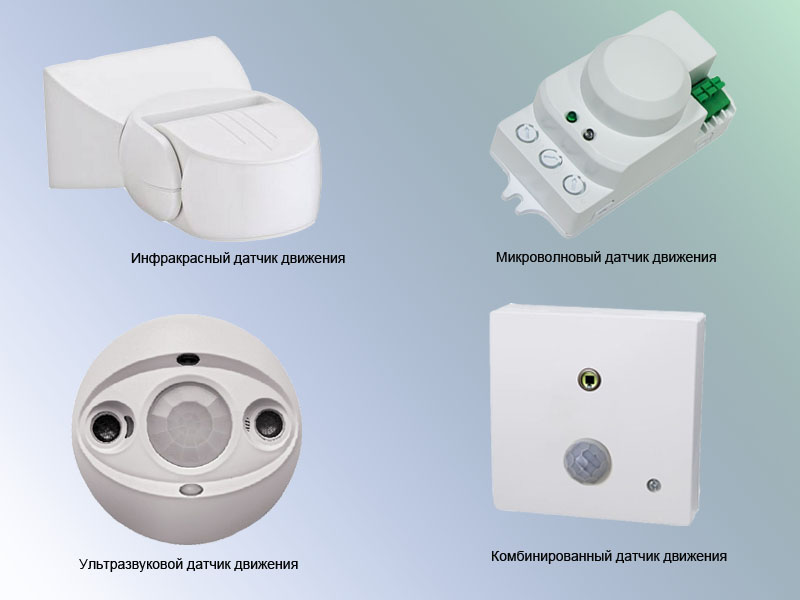
Motion detection devices work on the principle of using electromagnetic radiation of different wavelengths. There are exotic capacitive sensors that are triggered when the capacitance changes when a person approaches a target object. They work at a short distance if someone has already reached out to the safe with money. They are used in special tracking systems and are not used for mass consumption.
Sensors of detection devices are divided into active, when the sensor sends waves to the working area and is triggered when the characteristics of the reflected wave change, and passive, which are triggered only when the wave radiation from a moving object is detected. Combined devices are also produced, using mainly infrared and microwave radiation at the same time.
The first are:
- ultrasonic;
- photovoltaic;
- microwave;
- radio waves.
The latter include infrared, which register heat waves from humans or animals.
Ultrasonic devices, sending high frequency sound waves, are triggered when the reflected signal from a detected object changes characteristics. This principle is used not only to detect a person, but, for example, when opening a garage door to turn on a light.
Photovoltaics work on the principle of interrupting the light beam. In this case, the receiving photo relay sends a signal to the actuator. It is very convenient for fixing the passage through a gate, door or turnstile.
Microwave and radio waves in essence use the same waves, only at different frequencies. Radio waves are rarely used because low-frequency radiation may not pass through some obstacles, such as metal walls or doors. Microwaves operate at frequencies above 5 gigahertz, this radiation penetrates any obstacle. They are all relatively expensive and used for large commercial spaces.
Active control sensors in the working area are more expensive than passive ones and are used in special conditions for the protection of very large objects. It is irrational to use them for household needs, including electricity. This also applies to combined analogs.
Structurally, thermal switching devices are made in various protected designs for indoor and outdoor use. The material for the enclosures is heat-resistant plastic. They are mounted on walls and ceilings at the manufacturer's recommended height.
How heat sensors work
What are they made of
The functioning of infrared devices is based on the analysis of radiation emanating from the working area. If there is no one in it, then the whole system is “silent”. As soon as a warm object appears, an electronic circuit analyzes the radiation emitted by it in terms of strength and coordinates in space.
The device consists of a system of lenses, each of which is responsible for collecting information from a narrow sector. The more there are, the higher the sensitivity of the tracking system. The radiation focused by adjacent lenses is sent to two thermal detectors made of pyroelectric crystals. If the signals from them differ, then the electronics turns on the switch, which closes the electrical load circuit. It is made on the basis of an electromagnetic relay or on powerful thyristors. The second option is more reliable, but also more expensive. This parameter is adjustable in many devices.
In order to save energy, switching devices should not work during daylight hours. To do this, a photo relay is installed in them, which reacts to daylight illumination. This parameter is adjustable and as soon as the illumination reaches the set minimum limit, it turns on. You can set a permanent mode of operation, independent of the time of day. The built-in timer adjusts the turn-on time of the electric lamp, which in most designs ranges from a few seconds to tens of minutes.
Some manufacturers offer standalone movement indicators. They run on batteries. In such devices, in order to save battery power, there are no adjustments. They work only in the dark with a constant turn-off delay time. Such devices are very convenient for lighting steep stairs, night routes to the toilet, in cellars and sheds. They attach easily to any surface and do not require wiring. Instead of lamps, they use LEDs.
Coverage area

The parameter that determines the distance at which the instrument detects movement is the coverage area and the horizontal and vertical angle of coverage. The sectors traced by the lenses diverge radially from the heat-sensitive element. The greatest sensitivity of the system is when a person crosses this area in the perpendicular direction, changing the characteristics of two adjacent sectors.
When moving to the sensor, frontal movement, the sensitivity is the smallest, since there is no abrupt change in radiation in the neighboring areas and the device works more slowly.
The coverage area does not exceed 12 meters in diameter for most devices, and the coverage angle is 360 or 180 degrees, depending on the specific requirements for the lighting control system.
If you are interested in the topic and wondered where to buy the best of the described devices, then the easiest way is to order online. A lot of material has been posted on the Internet on how to install the sensor yourself. You can assemble the electrical connection diagram with your own hands without any problems
Rating of quality motion sensors for turning on lights in 2020
| Sensor name | Action radius, m | Load power, W | Angle of view deg. | Price, rub. |
|---|---|---|---|---|
| Feron 22072 motion sensor | 6 | 2000 | 360 | 680 |
| Camelion LX-20B motion sensor | 6 | 1200 | 360 | 540 |
| Motion sensor REV Ritter "AKTION" | 12 | 1200 | 110 | 310 |
| IEK motion sensor "DD 009" | 12 | 1100 | 180 | 500 |
| Navigator 61 653 NS-IRM09-WH sensor | 8 | 800 | 360 | 430 |
| Motion detector EGLO DETECT ME 1 96454 | 8 | 800 | 180 | 1490 |
| Lamp with motion sensor "Mighty light" | 4 | 0.225 | 180 | 400 |
| Camelion LX-451 9174 motion sensor | 6 | 60 | 360 | 630 |
| Infrared motion sensor N1534-01 200W | 8 | 200 | 360 | 490 |
| ERA MD 04 motion sensor | 12 | 1200 | 180 | 410 |
Feron 22072 motion sensor
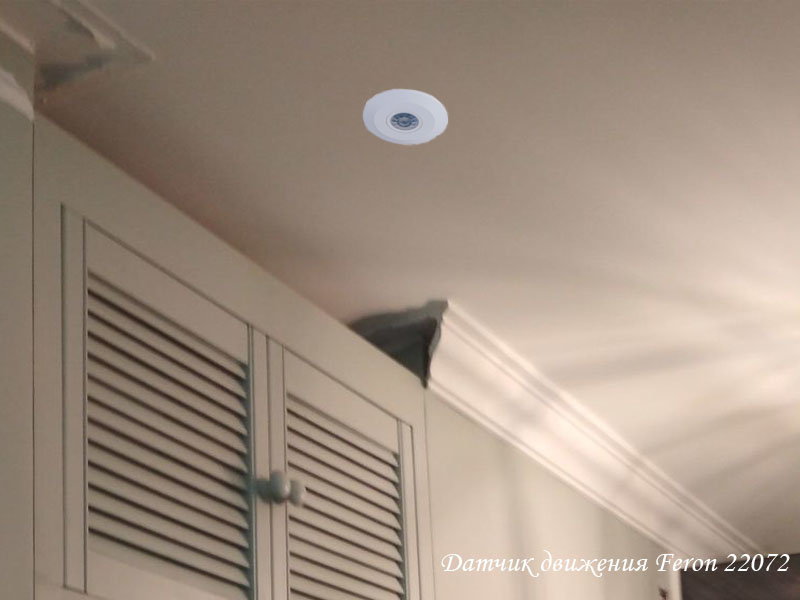
The infrared touch-sensitive ceiling device with the function of detecting moving people is intended for indoor use, since the low degree of protection excludes installation in conditions of water ingress. Used in the electrical circuit for lighting objects, it automatically turns on lamps with a power of up to 2000 W and an inductive load (for example, a gate opening motor) up to 1000 W.
Installed on the ceiling, it provides a detection area of 180 degrees horizontally and 360 degrees vertically. The maximum distance to moving people is 6 meters. The sensitivity of the sensor is not adjustable, and the detection speed ranges from 0.6 to 1.5 m / s. The delay time can be set from 10 sec. up to 15 minutes. Illumination control within the range of 3-2000 lux ensures the functioning of the system at any time of the day.
Recommendations for ceiling mounting at a height of 2.2-4 meters make it suitable for industrial premises.
Advantages:
- active load power 2000 W;
- the ability to connect an inductive load with a power of 1000 W.
Disadvantages:
- unregulated detection sensor;
- low degree of environmental protection.
Camelion LX-20B motion sensor
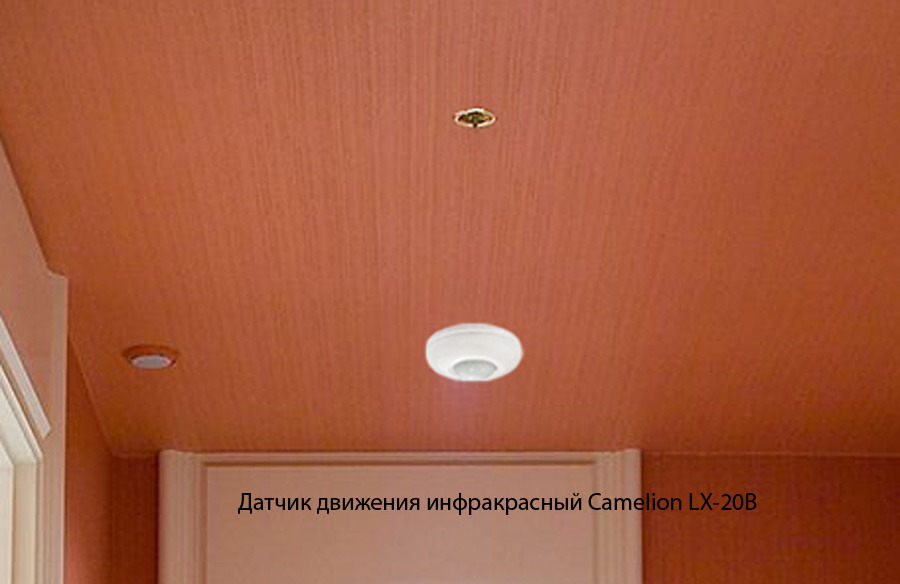
The infrared movement indicator represents the budget analogs of the Chinese company "Camelion". Built-in integrated circuit and broadband IR sensor provide compact design and reliable detection of moving warm-blooded objects. Designed for both individual use and for apartment buildings when illuminating entrances and corridors.
The switched load power is 1200 W for incandescent lamps and 300 W for LED and fluorescent lamps. The radius of the working area is 6 meters at a detection angle of 360 degrees. There are two adjustments. The turn-off delay time ranges from 10 seconds to 7 minutes. Daylight illumination varies from 3 to 2000 lux, from a moonless night to a sunny day. The device is triggered when the set level is reached.
The ceiling version limits the installation height from 2 to 4 meters. The degree of protection IP20 does not recommend installing the product in dusty rooms and in direct contact with water, which excludes outdoor conditions.
Advantages:
- for both individual and public premises;
- reasonable average price in any online store.
Disadvantages:
- weak degree of protection;
- only the white color of the product.
Motion sensor REV Ritter "AKTION"

The Chinese representative from the German brand REV of wall and ceiling design with IP44 degree of protection, which provides for installation on the street under a canopy, is suitable for installation near entrances to premises, for summer cottages and for entrances in residential buildings.
The built-in control varies the lamp off time from 10 seconds to 7 minutes and the illumination of the sensor from complete darkness (3 lux) to half-day sunny (2000 lux). The coverage area at 110 degrees horizontally reaches 12 meters. In frontal approach, the sensitivity decreases slightly. These characteristics cover the entire spectrum of consumer requirements for the product.
It is recommended to mount the device at a height of 1.8-2.4 m for wall mounting and up to 4 m for ceiling mounting. A false alarm occurs when the sensor is exposed to direct sunlight and heat from open windows and doors.
Advantages:
- quality of the German brand;
- wall-ceiling version;
- outdoor operating conditions;
- low price.
Disadvantages:
- lack of sensor sensitivity adjustment.
IEK motion sensor "DD 009"
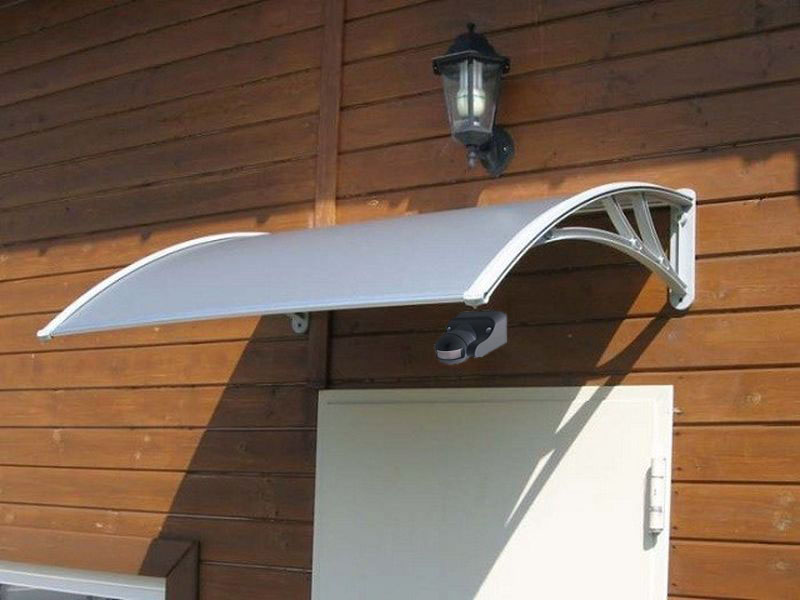
The wall-ceiling IR motion sensor is designed to turn on electric lamps at home, it is used for installation on stairs or in the entrance, when it is indoors without exposure to dust and heavy rain. The device provides for adjustment of the shutdown delay time and daylight illumination. Angle of view 180 degrees with a detection range of a thermal object up to 12 meters.
Its electric power is 0.45 W with a maximum load of 1100 W incandescent lamps, 600 W fluorescent and 300 W LED lamps. When adjusting the illumination threshold, the “sun” sign means that the device is always ready at any time of the day, the “moon” sign for night time. The load is switched by an electronic circuit.
The switch-on time is set from 10 seconds to 7 minutes. Installation at a height of 1.8-2.5 meters is recommended. The device has the lowest sensitivity when it is approached from the front; it can be triggered when electromechanical interference occurs during a thunderstorm.
Advantages:
- profitability;
- installed both on the wall and on the ceiling;
- with constant movement, the light remains on.
Disadvantages:
- there is no sensitivity adjustment to the movement of a warm object.

Introduces the Navigator series of products for automatic switching on of lighting of objects and various electrical devices, alarm devices, video cameras. The set with a remote sensor includes a control unit with adjusting rheostats. The maximum working area of the gripper in the horizontal plane has a radius of 8 meters. In frontal approach, the threshold is 6 meters. Ceiling and wall mounting.
The electrical power of the connected incandescent lamps should not exceed 800 W, fluorescent and LED lamps should not exceed 400 W. The device itself consumes 0.45 watts. The built-in photocell provides a threshold for illumination from 10 to 2000 lux, it can be adjusted. When the regulator is set to the "sun" sign, it starts to work constantly regardless of the time of day.
Sensitivity adjustment is provided horizontally from 4 to 8 meters and vertically from 3 to 6 meters. The load off delay is adjustable from 5 seconds to 8 minutes. It is mounted on the wall at a height of 1.8-2.5 meters, on the ceiling from 2.2 to 4 meters.
Advantages:
- the presence of sensitivity adjustment;
- compactness of the remote sensor;
- complete protection from dust and rain in all directions.
Disadvantages:
- low load power.
Motion detector EGLO DETECT ME 1 96454

Austrian wall-mounted infrared movement indicator in a rugged design for outdoor use.The angle of coverage in the horizontal plane is 180 degrees, in the vertical plane is 45 degrees. Therefore, it is mounted in the wall at a height of 1.8-2.5 meters.
Designed for street lighting systems and rooms with high humidity. Maximum electrical power for incandescent lamps 800 W, fluorescent lamps 400 W and LED 200 W. The operating radius is 8 meters, which is sufficient for any switching circuits of the device.
Two rheostats are built in. One regulates the luminous flux per unit area from 3 to 2000 lux, and the second sets the lamp burning time after stopping movement in the observation area in the range of 10-15 minutes. The sensitivity decreases when it hits direct sunlight or light from a lamp, and also reacts to heat sources. It is not recommended to have swaying trees in front of it.
Advantages:
- traditional Austrian quality;
- made for high humidity conditions;
- 15 minutes of burning light is enough to use it as a source of constant lighting in storerooms, cellars, garages, etc.
Disadvantages:
- hypersensitivity to heat sources;
- overpriced according to buyers.
Lamp with motion sensor "Mighty light"
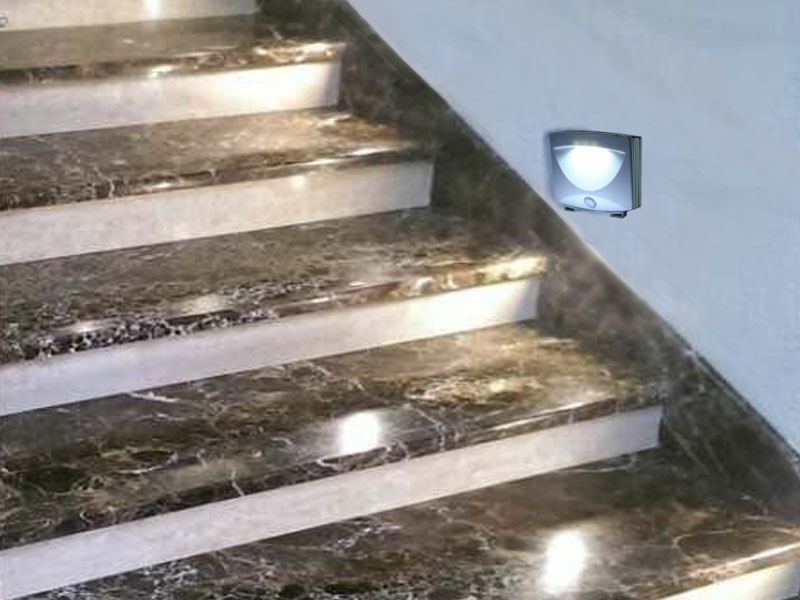
The Israeli development is designed to promptly solve the problem of lighting "bottlenecks" of your farm without laying electrical wiring. An indication sensor built into the luminaire detects a moving object and it turns on. The device is powered by a Krona battery and is attached to any surface using dowels or double-sided tape.
The device does not have toggle switches; instead of a lamp, two LEDs are used for lighting. After movement is detected, it turns off after 30 seconds. If the object continues to move, it turns on for another 30 seconds after the last detection. There are no adjustments in it, so the burning time is constant and in the daytime it is turned off to save battery power. The radius of the capture zone is 4 meters. Protected from dust and rain, so it can be used outdoors.
The device has a wide range of applications. Install in your car, on a steep staircase, in a cellar or shed and you will always be in comfortable lighting conditions.
Advantages:
- full autonomy;
- can be installed anywhere and on any surface.
Disadvantages:
- there are no adjustments due to the need to save the battery.
Camelion LX-451 motion sensor
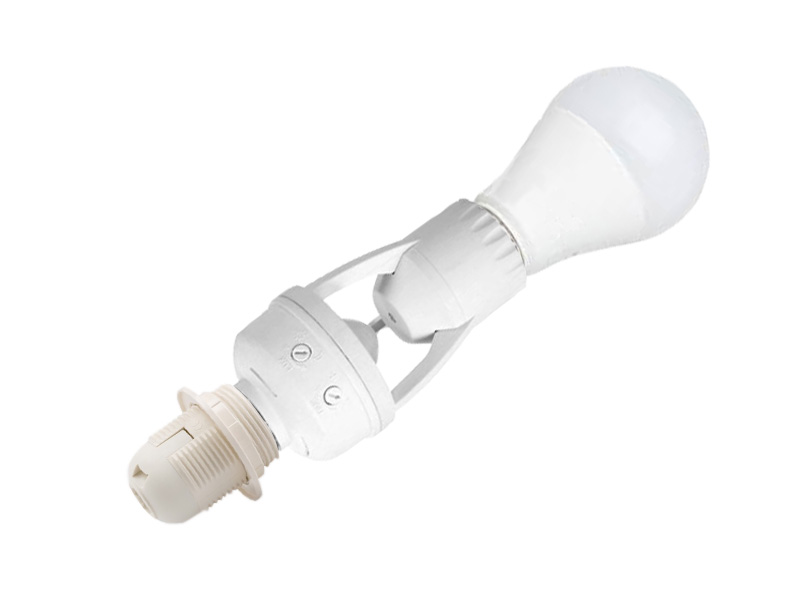
The design of the device is made in the form of a plastic holder E27 with the same lamp base. Screws in instead of a lamp, which makes it convenient in everyday life. This type of device is installed where at a certain time it is required to solve the problem of illumination. No electrical wiring required. A screwed-in lamp with a power of no more than 60 watts lights up when movement is detected at a speed of 0.6 m / s to 1.5 m / s. Not suitable for outdoor use due to low protection class.
Ceiling sensor with a working area of 6 meters. The turn-on delay time can be adjusted from 5 seconds to 2 minutes and daylight illumination from 3 to 2000 lux. Used in hallways, garages, storerooms, etc.
Advantages:
- autonomy, no need for wiring;
- acceptable price;
- adjustment by two parameters.
Disadvantages:
- low power of the controlled load;
- weak degree of protection.
Infrared motion sensor N1534-01 200W

The Austrian-made infrared lighting device is small in size, 25x35 mm. The main purpose is to automatically turn on the lamps when there is movement in the control zone. Street design allows you to use it in the organization of lighting in summer cottages, in garages, cellars and in similar utility rooms.
The device turns on the lamps when the illumination decreases and the movement of an object is detected in the field of view. It turns off after 45 seconds, this time is not adjustable, but it is enough to turn on the main lighting.There is no daylight adjustment as an enable parameter.
The low power of 200 watts limits the use of connecting LED lamps. The maximum range of 8 meters is sufficient for street lighting applications
The design of the product makes it easy to embed it into any surface. Installed in the object lighting system or directly with the luminaire.
Advantages:
- the compactness of the sensor makes it "invisible";
- Austrian quality of production;
- the possibility of cutting into any vertical or horizontal surface.
Disadvantages:
- lack of sensitivity adjustment;
- unchangeable turn-on time.
ERA MD 04 motion sensor

Inexpensive wall-mounted infrared devices are designed for indoor use in residential and industrial premises. In outdoor conditions, protect it from direct exposure to rain and snow with a visor. Provides illumination of objects as long as there is movement of people in the detection area. Indispensable in systems for intelligent switching on of electricity.
The functionality of the device provides for adjusting the sensitivity of human detection at a distance of 5 to 12 meters. The sensor recognizes a person and excludes triggering when animals enter the working area. The delay time for turning on the load varies from 10 seconds to 7 minutes. Daytime illumination is changed by the regulator from complete darkness to continuous operation during the daytime.
The device is mounted on a wall at a height of 1.8-2.5 meters. Its bracket provides the ability to rotate around its own axis. This makes it possible to improve the directional accuracy of the sensor's sensitivity zone.
Advantages:
- adjustment of the direction of the sensitivity zone;
- the sensor is triggered by the movement of a person, not animals;
- the best price-reliability ratio.
Disadvantages:
- according to consumers, none.
Conclusion
The article contains a description of motion sensors to turn on the light. The types of devices and their principle of operation are considered. The popularity of models makes it difficult to choose the best of the devices, therefore advice is given on which selection criteria to use when buying them and which one is better to buy.
Do you already have experience with similar devices? Share this with your readers, tell us what to look for so that mistakes when choosing do not cloud their impressions. Leave your feedback on the selected sensors in the comments.












